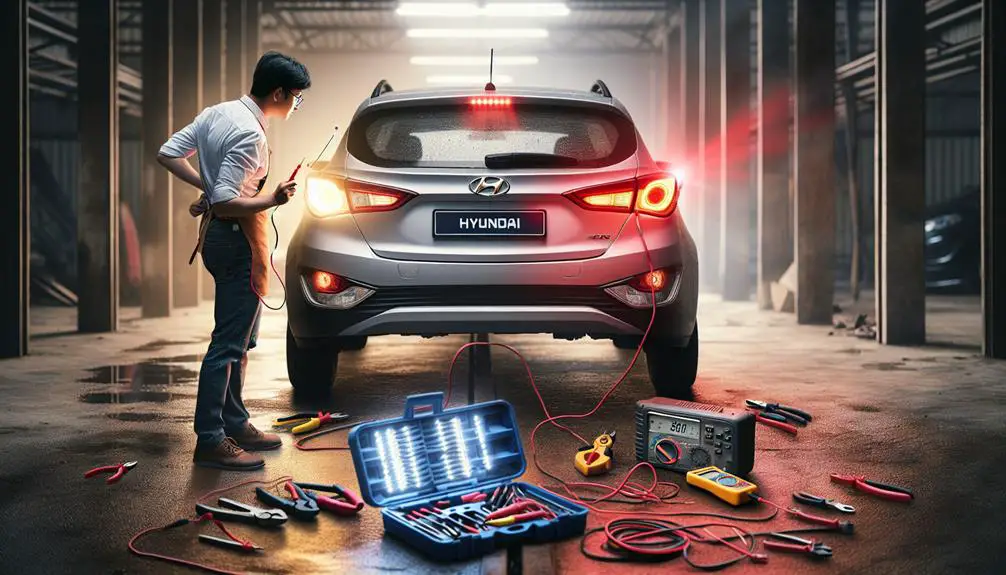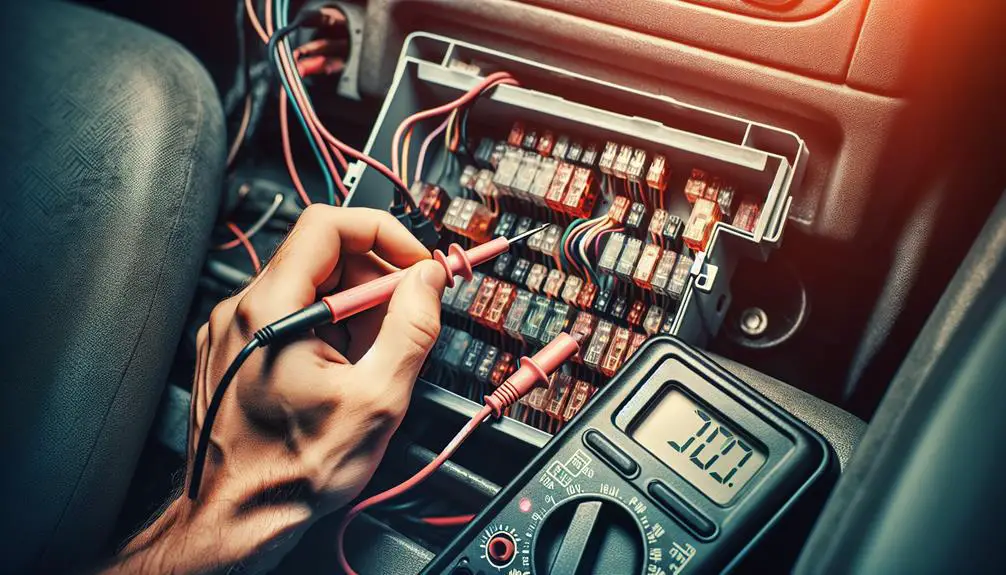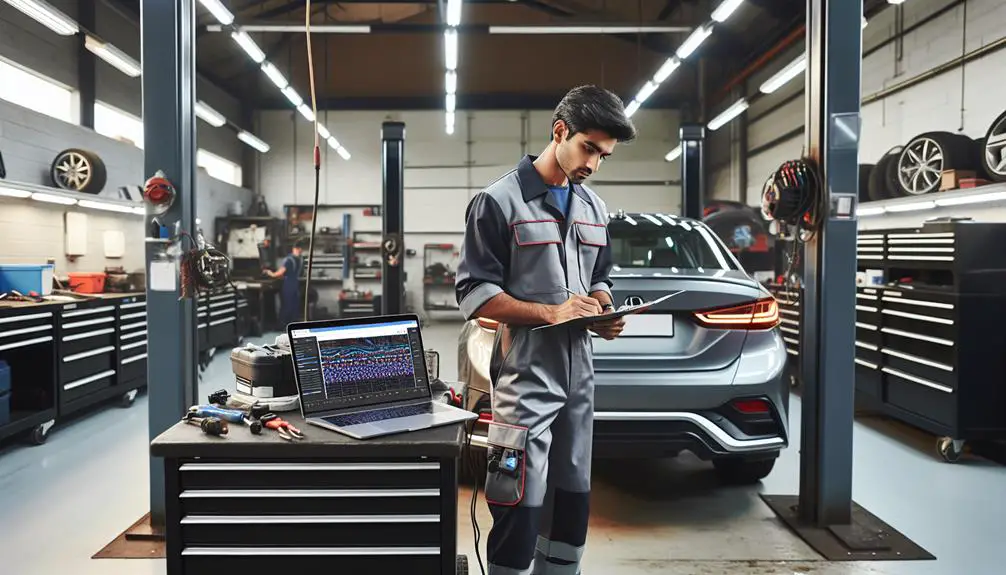- Bulbs: Start by checking the bulbs to see if they are burnt out or damaged. If so, replace them with new ones that are compatible with your Hyundai model.
- Fuse: Next, inspect the fuse related to the brake light to determine if it has blown. If it has, replace it with a new fuse of the same amperage to restore functionality.
- Wiring: Lastly, examine the wiring connected to the brake light to ensure there are no loose connections or frayed wires. Repair or replace any damaged wiring to guarantee a secure electrical connection.
Identifying the Problem

To pinpoint the issue with your Hyundai's brake light not working, start by checking the fuse and bulb. However, since we're not diving into the bulb specifics just yet, you'll want to focus on the fuse initially. It's a common culprit when lights fail to work, and fortunately, it's a straightforward fix. Your Hyundai's manual will indicate where the fuse box is located and which fuse corresponds to the brake lights. If the fuse looks blackened or broken, you've found your problem. Simply replacing it might get your brake lights back in action.
But suppose the fuse isn't the issue. In that case, you'll need to take other possibilities that could be preventing your brake lights from working. One often overlooked aspect is the brake light switch. This switch activates your brake lights when you press the brake pedal. If it's faulty or misaligned, your brake lights won't light up. Locating and checking this switch for any signs of damage or misalignment could reveal the problem.
Don't ignore the wiring leading to the brake lights. Damaged or frayed wiring can disrupt the power flow, leaving your brake lights unresponsive. You'll need to inspect the wires carefully for any signs of wear or tear. If you're not comfortable doing this yourself, it might be time to consult a professional. They can perform a more thorough investigation and repair any complex issues, ensuring your safety on the road.
Checking the Bulbs
After checking the fuse and brake light switch, it's important you examine the bulbs themselves for any signs of damage or burnout. This step is often overlooked but is necessary in troubleshooting your Hyundai's brake light issue. The process is straightforward but requires your attention to detail to make sure you don't miss any signs of wear or failure.
To make your task easier, follow these steps:
- Remove the Bulb: Initially, you'll need to access the brake light assembly. Typically, this involves removing some screws or clips that hold the light cover in place. Once you have access, gently twist the bulb holder and pull it out. Be careful not to use excessive force to avoid breaking anything.
- Inspect the Bulb: Look closely at the bulb. Are there any dark spots, or does the filament appear broken? These are telltale signs of a burnt-out bulb. Sometimes, the issue mightn't be visible, so proceed to the next step regardless.
- Test with a New Bulb: Even though the bulb looks fine, the best way to be sure is to replace it with a new one. Bulbs are relatively inexpensive and widely available. After inserting the new bulb, test your brake lights again. If they light up, you've solved the problem. If not, the issue lies elsewhere in the system.
Inspecting the Fuse

Before moving further, make sure you've closely inspected the brake light fuse, as a blown fuse is a common culprit behind malfunctioning brake lights. Locating and examining the fuse might seem challenging, but it's a straightforward process that you can do on your own with a little guidance.
Dance, you'll need to find your Hyundai's fuse box. It's typically located under the dashboard on the driver's side or in the engine compartment. Your owner's manual will have the exact location and a diagram showing which fuse is for the brake lights.
Once you find the fuse box, look for the brake light fuse. It's usually labeled 'STOP' or 'BRAKE' on the fuse box cover. Remove this fuse and inspect it. If the metal strip inside is broken or the fuse appears burnt, it's blown and needs replacement.
Here's a quick reference table to help you:
| Condition | Action Needed |
|---|---|
| Metal strip intact | Fuse is good; further inspection needed |
| Metal strip broken | Fuse is blown; replace with identical fuse |
| Fuse appears burnt | Replace with identical fuse |
When replacing a fuse, make sure you use one with the same amperage rating to avoid any electrical issues. After replacing the fuse, test your brake lights. If they're working, you've solved the issue. If not, further investigation will be necessary, but you've ruled out a simple yet common problem. Remember, always handle electrical components with care to avoid damage or injury.
How Do I Fix My Hyundai’s Brake Light Issue?
Experiencing a Hyundai brake light issue? Fix it quickly and easily by first checking the brake light switch, fuse, and bulbs. If those are in good condition, the problem may be with the wiring or the brake light assembly itself. Consulting a professional for a hyundai brake light issue fix may be necessary.
Evaluating Wiring Issues
If your Hyundai's brake lights still aren't working after checking the fuse, it's time to explore into potential wiring issues. Wiring problems can be a bit trickier to diagnose than a simple fuse replacement, but with some patience, you can figure it out. Here's how you can start evaluating the wiring to guarantee your brake lights function correctly again.
- Examine the Brake Light Switch: The brake light switch, located near the brake pedal, activates your Hyundai's brake lights when you press the pedal. If this switch's wiring is loose, frayed, or disconnected, your brake lights won't work. Check the switch's connections and make sure they're secure. If the wires look damaged, they may need to be replaced or repaired.
- Look for Corroded or Damaged Wires: Over time, your car's wiring can suffer from corrosion, particularly if you live in a wet or salty environment. Examine the wires leading to the brake lights for any signs of corrosion or damage. Corroded wires can disrupt the electrical flow, causing your brake lights to malfunction. If you find any damaged wires, they'll likely need to be cleaned or replaced.
- Check the Ground Connection: A poor ground connection can also be the culprit behind non-functioning brake lights. The ground wire, usually black, should be securely connected to the car's body. If this connection is loose or corroded, it can prevent your brake lights from working. Ensure the ground connection is clean, secure, and free of rust or corrosion.
Professional Repair Solutions

When you've tried everything and your Hyundai's brake lights still aren't working, it might be time to consult a professional mechanic. It's a step you shouldn't shy away from, as brake lights are important for your safety on the road. A professional can offer a complete check that goes beyond the basics you can do at home.
Initially, they'll likely start with a diagnostic test to pinpoint the exact issue. This might involve checking the electrical system for any faults that aren't immediately visible. They have the tools and expertise to test the wiring thoroughly and the connections to the brake light switch and the lights themselves.
If the problem is with the wiring or the electrical connections, a mechanic can repair or replace these parts with precision. They'll make sure everything is up to standard and won't leave you with a half-fixed problem that could recur in the future.
In cases where the issue might be more complex, like a problem with the car's onboard computer system, a professional has the know-how to update or reset the system as needed. This isn't something you'd typically be able to handle on your own without the proper equipment.
Conclusion
You've now learned how to tackle a Hyundai brake light issue. Whether it's checking bulbs, inspecting fuses, or evaluating wiring, you've got the knowledge.
If these steps don't fix the problem, don't hesitate to seek professional help. Remember, keeping your car's brake lights in working order is vital for your safety and that of others on the road.
So, take action right away and guarantee you're always shining bright, even from behind.